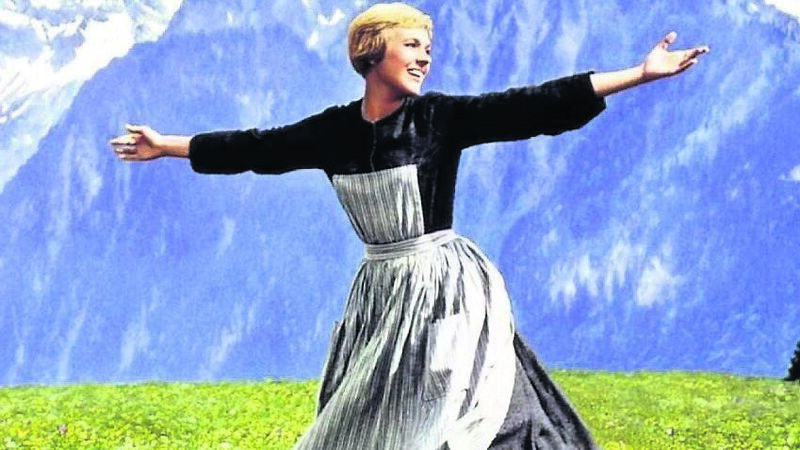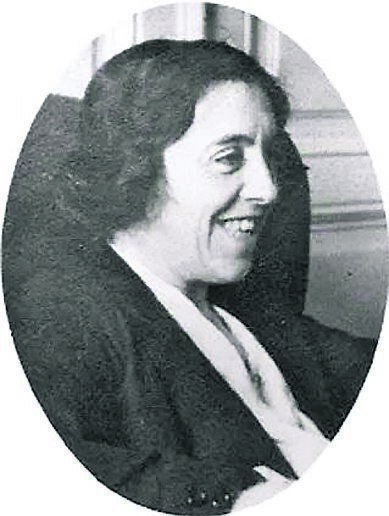Clodagh Finn: The Limerick woman who married into the real von Trapp singing family

Julie Andrews in the film ‘The Sound of Music’.
THE story of how Constance O’Mara, of the Limerick bacon-factory family, came to marry an uncle of the real singing von Trapps — made famous by The Sound of Music — is worthy of a film in itself.
The improbable family link is recalled by her relatives every Christmas when the musical, with its sentimental mix of music, love and patriotism, beams into festive living rooms.
“It’s my claim to fame,” says one of them, Eoghan O’Mara Walsh, a cousin and CEO of the Irish Tourism Industry Confederation. He says people often don’t realise the von Trapps were a real family, much less that an Irishwoman married one of them.
He is only too happy to tell them about his great-uncle’s daughter Constance, or Connie as she was known, who moved to Vienna as a young woman in 1913 to work as a governess. There, she met Baron Werner von Trapp and married him the following year to become Baroness von Trapp. (Werner’s brother was Georg Ritter, retired naval captain and the patriarch portrayed in The Sound of Music.)
The couple had a daughter, also Connie, the following year, but then tragedy struck. Connie’s husband was killed in action on May 2, 1915.
It was a debilitating blow. And one that must have reminded Connie of her early childhood loss.

Her father James O’Mara ran the O’Mara bacon factory’s London office. He died in 1893 and his wife Mysie McKenna died shortly afterwards, in 1898, leaving Constance (then just six) and her sister Hanora (Daisy) as orphans.
They went to boarding school and were raised by other family members. The family lore grows a little sketchy after that, but the story is taken up by Sharon Slater, historian and author of The A-Z of Curious County Limerick.
After her husband died, Slater says, Connie moved back to Limerick for a short period, but the political turbulence and violence at home prompted her to return to Austria.
At that point, she moved in with her in-laws, the real von Trapps, in Klosterneuburg, Austria. While the broad strokes of the film telling the story of a family fleeing the Nazi annexation of Austria in 1938 hold up, family members were particularly upset about the portrayal of their warm-hearted father by Christopher Plummer as cold and distant.
The real story behind the sugar-coated Hollywood version is well-known, though few are aware of Connie O’Mara, the Irish von Trapp. Historian Sharon Slater has helped to rescue her from obscurity and points to some revealing insights in her niece, Agathe von Trapp’s memoir. (Aka, Liesl who sings I am 16 going on 17 on screen.
Here is what Agathe wrote when she heard that Constance O’Mara was coming to stay.
“One day Mamá called us all together and said, ‘I invited Tante [aunt] Connie and Connie Baby to come and live with us. In Ireland there is a terrible war, and they are not safe. You must accept Connie Baby as one of your sisters because she has lost her father and has no brothers and sisters.’ We promised to do just that. Of course, we older children already knew them from our time together ... during World War I, after which Tante Connie and Connie Baby had returned to Ireland.”
Agathe goes on to explain that the Civil War in Ireland solved the family’s nursery problem. Tante Connie was put in charge of the little ones, a number of years before Maria Kutschera, played by Julia Andrews, arrived to tutor one of the von Trapp children in 1926. (She was a tutor rather than the governess portrayed in the film).
In the early 1920s, though, the von Trapp children were delighted to have their Irish aunt staying with them. As Agathe attests: “Tante Connie loved children, she had a good heart and a sense of humour, and she could maintain discipline. Mamá was glad to have an intelligent relative in the house to discuss children and housekeeping. Tante Connie’s philosophy of life was ‘live and let live’.
She knew what heartache was, having lost her husband, our Uncle Werner, in the war.”
There’s an evocative description of Connie working with her sister-in-law, also Agathe, making knee-high snow boots for the seven children, using heavy felt and brown carpetlike material for the soles.
Connie looked after the children when Agathe got sick with scarlet fever and, later, when she died of it in 1922. After her death, her daughter wrote: “Some of us started to cry, and Tante Connie tried to comfort us. ‘Now you will be our mother,’ I said to her. I did not really mean for her to replace Mamá, but in my nine-year-old mind, I sensed that a mother was needed.”
As it turned out, the von Trapp children were sent away to school and later, in 1926, the now-famous Maria arrived.
In the meantime, Connie moved in with the children’s maternal grandmother, another Agathe (Whitehead). And here’s an interesting aside: her father, Robert Whitehead, invented the torpedo in 1912. Agathe Whitehead, mother of the von Trapp children, had shares in the company which made her a woman with a fortune in her own right.
When the von Trapp family left Austria for the States, Connie and her daughter stayed behind. She married again in 1941, becoming a countess this time as wife of Count Johann Herbert of Herberstein Castle, a man seven years her junior.
Historian Sharon Slater continues the story: “Through marriage she was related to the author Kate O’Brien. She visited Limerick on several occasions while she was Baroness von Trapp and Countess Herberstein.”
After she died, on March 24, 1952, her daughter Connie also visited Limerick and, at one stage, stayed with her cousins in Strand House while attending a lecture by author Kate O’Brien. When she married, she kept the von Trapp name as she was the last of the family in Austria.
Musical gene
We don’t know if either Connie could sing, but the musical gene was certainly present in the O’Mara family of Limerick. Connie senior’s uncle Joseph O’Mara was a well-known operatic tenor and mentor to John McCormack. He was made a free man of Limerick city in 1908 and, in 1926, was the first tenor to be broadcast when RTÉ’s radio service went on air.
Two generations later, his grand-daughter Eileen O’Mara Walsh chaired the board of Opera Ireland, and much else besides including founding and becoming the first chairwoman of the Irish Tourist Industry Confederation, but that’s a story for another day. Her son, Eoghan, is now CEO of that organisation which brings us back to where we came in – in front of the festive television remembering the story of a forgotten Irishwoman.
Raise a toast to Constance O’Mara if you find yourself singing along to The Sound of Music this Christmas.
As Sharon Slater comments: “Once we start digging, those amazing women are everywhere.”
Here’s to unearthing them, one by one.

Subscribe to access all of the Irish Examiner.
Try unlimited access from only €1.50 a week
Already a subscriber? Sign in
CONNECT WITH US TODAY
Be the first to know the latest news and updates











